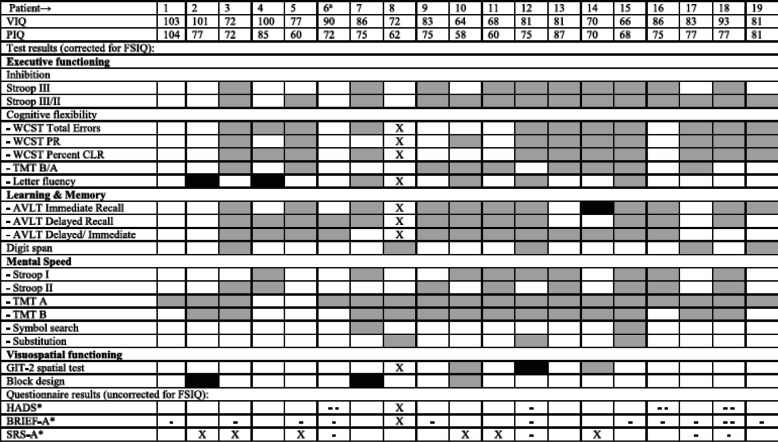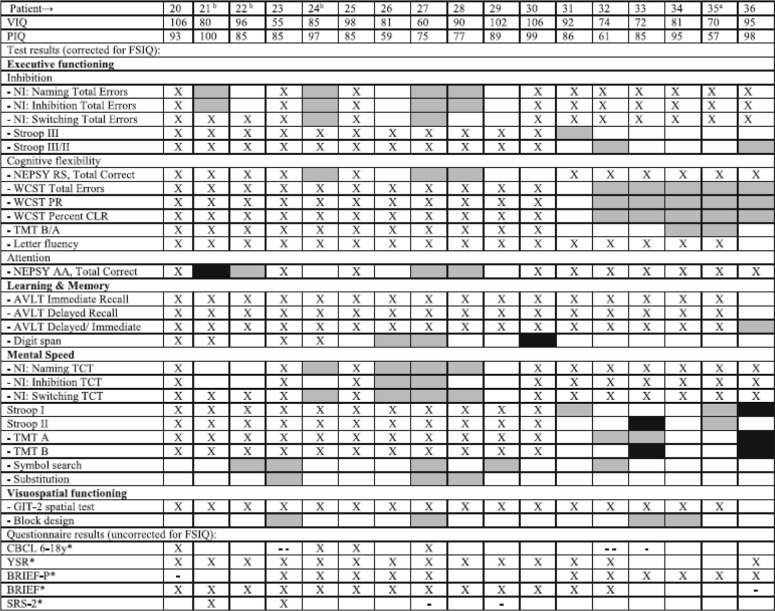Correction to: Orphanet Journal of Rare Diseases (2020) 15:42
https://doi.org/10.1186/s13023-019-1277-0
Following the original article’s publication [1] the authors informed us of the following errors:
1. Author M. Estela Rubio Gozalbo’s first and last names were captured incorrectly. The author’s first names are M. Estela, while last names are Rubio Gozalbo.
The correct author’s name has been updated in the original article [1] and shown in the author list of this Correction.
2. In Table 2 ‘Digit span’ and ‘GIT-2’ are tests and should be preceded by a - just like the other tests in the table.
Table 2.
Cognitive Functioning Results
| Domain | N | Results patients | P-valuea | N | FSIQ 50–69 (Group 1) | N | FSIQ 70–85 (Group 2) |
N | FSIQ > 85 (Group 3) |
P-valueb |
|---|---|---|---|---|---|---|---|---|---|---|
| Learning & Memory | ||||||||||
| - AVLT Immediate Recall | 19 | 46.0 (9–61) | 0.029 | 4 | 40.0 (9–46) | 11 | 45.00 (35–61) | 4 | 49.50 (47–51) | 0.121 |
| - AVLT Delayed Recall | 19 | 46.0 (15–65) | 0.545 | 4 | 49.5 (15–58) | 11 | 46.00 (34–65) | 4 | 50.00 (43–55) | 0.956 |
| - AVLT Delayed / Immediate | 19 | 52.0 (38–65) | 0.445 | 4 | 55.5 (43–62) | 11 | 52.00 (38–65) | 4 | 52.00 (39–62) | 0.803 |
| - Digit span | 35 | 43.0 (20–63) | < 0.0005c | 8 | 30.00 (20–57) | 15 | 43.00 (27–60) | 12 | 48.50 (33–63) | 0.017 |
| Visuospatial functioning | ||||||||||
| - GIT-2a spatial test | 19 | 36.0 (23–50) | < 0.0005c | 4 | 26.5 (23–40) | 11 | 35.0 (28–40) | 4 | 41.5 (40–50) | 0.019 |
| - Block design | 42 | 38.5 (20–53) | < 0.0005c | 9 | 30.0 (20–40) | 17 | 37.0 (27–50) | 16 | 37.0 (33–53) | < 0.0005c |
| Executive functioning | ||||||||||
| Inhibition | ||||||||||
| - Stroop III (Inhibition) | 25 | 45.0 (20–56) | 0.003c | 6 | 27.0 (20–49) | 13 | 48.00 (22–56) | 6 | 46.0 (35–53) | 0.078 |
| - Stroop III/II (Interference) | 25 | 49.0 (30–66) | 0.537 | 6 | 43.0 (30–60) | 13 | 50.00 (31–66) | 6 | 47.5 (40–63) | 0.642 |
| Cognitive flexibility | ||||||||||
| - WCST Total number of errors | 24 | 50.5 (27–67) | 0.988 | 6 | 46.0 (27–50) | 12 | 51.50 (37–67) | 6 | 52.0 (39–64) | 0.134 |
| - WCST Perseverative responses | 24 | 51.0 (30–81) | 0.626 | 6 | 46.0 (33–52) | 12 | 53.00 (30–81) | 6 | 52.0 (35–73) | 0.278 |
| - WCST Percent conceptual level responses | 24 | 49.5 (27–64) | 0.951 | 6 | 48.0 (27–51) | 12 | 52.00 (39–64) | 6 | 51.0 (37–62) | 0.270 |
| - TMT B/A | 25 | 44.0 (27–57) | 0.002c | 6 | 45.0 (27–50) | 13 | 43.00 (27–57) | 6 | 48.5 (40–57) | 0.510 |
| - Letter fluency | 19 | 37.0 (27–67) | 0.001c | 4 | 31.0 (28–38) | 11 | 39.00 (31–67) | 4 | 34.0 (27–56) | 0.143 |
| Mental Speed | ||||||||||
| - Stroop I (Color naming) | 25 | 40.0 (25–61) | 0.001c | 6 | 35.0 (25–43) | 13 | 43.00 (35–61) | 6 | 46.5 (33–55) | 0.077 |
| - Stroop II (Word reading) | 25 | 37.0 (20–56) | < 0.0005c | 6 | 30.0 (20–40) | 13 | 43.00 (20–56) | 6 | 39.0 (33–56) | 0.063 |
| - TMT A (Digit sequencing) | 25 | 52.0 (20–67) | 0.352 | 6 | 50.5 (20–59) | 13 | 56.00 (43–67) | 6 | 47.5 (33–67) | 0.173 |
| - TMT B (Digit-Letter-Switching) | 25 | 45.0 (20–58) | 0.003c | 6 | 33.5 (20–47) | 13 | 46.00 (20–58) | 6 | 45.0 (33–56) | 0.111 |
| - Symbol search | 41 | 43.0 (20–67) | < 0.0005c | 9 | 23.0 (20–50) | 17 | 40.00 (27–67) | 15 | 47.0 (40–60) | 0.001c |
| - Substitution | 42 | 40.0 (23–57) | < 0.0005c | 9 | 30.0 (23–47) | 17 | 40.00 (30–57) | 16 | 43.0 (33–53) | 0.006 |
Data reported in T-scores, median (ranges). a Patient data vs. normative data (T-score 50), b Comparison between FSIQ groups, c Significant after Bonferroni-Holm correction. FSIQ full scale IQ, AVLT auditory verbal learning test, GIT-II groninger intelligentie test 2, Stroop stroop color word test, WCST wisconsin card sorting test, TMT trail making test
Furthermore, ‘Responses’ is not a domain and should therefore be deleted.
Finally, ‘Cconceptual’ should be corrected to ‘conceptual’.
The table is shown here corrected.
3. The grey box for ‘test result better than expected’ is missing from the legends of Tables 4 and 5.
Table 4.
Individual Results, Adult Patients
ap.Ser135Leu homozygous patient. VIQ Verbal IQ, PIQ Performal IQ, FSIQ Full Scale IQ, Stroop Stroop Color Word Test, WCST Wisconsin Card Sorting Test, PR Perseverative Responses, CLR Conceptual Level Responses, TMT Trail Making Test, AVLT Auditory Verbal Learning Test, GIT-II Groninger Intelligentie Test 2, HADS Hospital Anxiety and Depression Scale, BRIEF Behavior Rating Inventory of Executive Function, SRS Social Responsiveness Scale
X no test result, ■ test result worse than expected,  test result better than expected, □ test result as expected
test result better than expected, □ test result as expected
*X no result, - - T-score on total scale in clinical range, - T-score on total scale in subclinical range, □ T-score on total scale within normal range
Table 5.
Individual Results, Pediatric Patients
ap.Ser135Leu homozygous patient, b Variant patient, VIQ Verbal IQ, PIQ Performal IQ, FSIQ Full Scale IQ, NI NEPSY Inhibition, Stroop Stroop Color Word Test, RS Response Set, AA Auditory Attention, WCST Wisconsin Card Sorting Test, PR Perseverative responses, CLR Conceptual Level Responses, TMT Trail Making Test, AVLT Auditory Verbal Learning Test, TCT Total Completion Time, GIT-II Groninger Intelligentie Test 2, CBCL 6–18y Child Behavior Checklist 6–18 years, YSR Youth Self Report, BRIEF Behavior Rating Inventory of Executive Function, SRS Social Responsiveness Scale
X no test result, ■ test result worse than expected,  test result better than expected, □ test result as expected
test result better than expected, □ test result as expected
*X no result, - - T-score on total scale in clinical range, - T-score on total scale in subclinical range, □ T-score on total scale within normal range
The two tables with their respective legends are shown here corrected.
4. In Table S8 of the Additional file 1, some rows have shifted. ‘Anxiety & Depression’ and ‘Social Functioning’ should be shown on separate lines. HADS should be in line with ‘Anxiety & Depression’ and SRS with ‘Social Functioning’.
In addition, subsequent references should be renumbered as 35–49.
The corrected Additional file 1 accompanies this Correction.
Supplementary information
Additional file 1: Table S8. The Neuropsychological Assessment.
Supplementary information
Supplementary information accompanies this paper at 10.1186/s13023-020-01447-z.
Reference
- 1.Welsink-Karssies MM, et al. Classical galactosemia: neuropsychological and psychosocial functioning beyond intellectual abilities. Orphanet J Rare Dis. 2020;15:42. doi: 10.1186/s13023-019-1277-0. [DOI] [PMC free article] [PubMed] [Google Scholar]
Associated Data
This section collects any data citations, data availability statements, or supplementary materials included in this article.
Supplementary Materials
Additional file 1: Table S8. The Neuropsychological Assessment.




